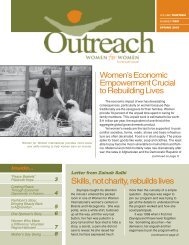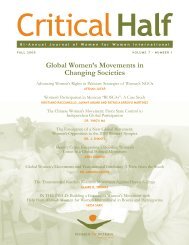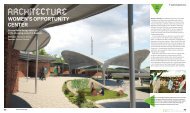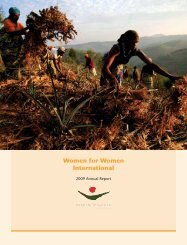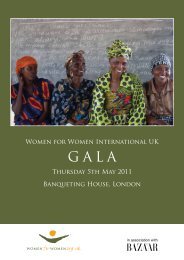Gender and Constitution Building - Women for Women International
Gender and Constitution Building - Women for Women International
Gender and Constitution Building - Women for Women International
Create successful ePaper yourself
Turn your PDF publications into a flip-book with our unique Google optimized e-Paper software.
3. The constitution should provide <strong>for</strong> independent<br />
bodies, whose members include women <strong>and</strong> are<br />
subject to gender training, to monitor <strong>and</strong> protect<br />
constitutional rights. Such en<strong>for</strong>cement mechanisms<br />
may include, <strong>for</strong> example:<br />
� Human rights commissions or ombudsman<br />
offices to evaluate human rights practices,<br />
consider individual cases <strong>and</strong> provide redress<br />
<strong>for</strong> violations<br />
� An independent judiciary<br />
4. The international community, regional organizations,<br />
civil society <strong>and</strong> local media should raise<br />
awareness about the importance of the constitution<br />
<strong>and</strong> women’s involvement in constitutionbuilding.<br />
5. <strong>Women</strong> <strong>and</strong> their communities, especially in rural<br />
areas, should receive education about constitutional<br />
rights during the constitution-building<br />
process <strong>and</strong> after the constitution has been<br />
ratified.<br />
JOLYNN SHOEMAKER is a Policy Officer at <strong>Women</strong> Waging<br />
Peace, an initiative of Hunt Alternatives Fund. She held<br />
previous positions with the U.S. Department of Defense <strong>and</strong> the<br />
U.S. Department of State. Shoemaker has written a more extensive<br />
discussion of constitution-building that appears in the<br />
<strong>Women</strong> Waging Peace/<strong>International</strong> Alert publication called, Inclusive<br />
Security, Sustainable Peace: A Toolkit <strong>for</strong> Advocacy <strong>and</strong><br />
Action, available at www.womenwagingpeace.net. She is also the<br />
author of “<strong>Women</strong> <strong>and</strong> Wars within States: Internal Conflict,<br />
<strong>Women</strong>’s Rights <strong>and</strong> <strong>International</strong> Security” (Civil Wars, Autumn<br />
2001) <strong>and</strong> “In War <strong>and</strong> Peace: <strong>Women</strong> <strong>and</strong> Conflict Prevention”<br />
(Civil Wars, Spring 2002). She holds an M.A. in national<br />
security studies <strong>and</strong> a J.D. from Georgetown University.<br />
BIBLIOGRAPHY<br />
Hart, Vivien. “Democratic <strong>Constitution</strong> Making.” United States Institute<br />
of Peace (USIP), Special Report No. 107 (2003).<br />
Hart, Vivien. “Owning the <strong>Constitution</strong>: A Path to Peace?” United States<br />
Institute of Peace (USIP), Senior Fellow Project Report (2003).<br />
Matembe, Hon. M.R.K. <strong>Constitution</strong> of Kenya Review Commission,<br />
“<strong>Women</strong> <strong>and</strong> <strong>Constitution</strong> Making in Ug<strong>and</strong>a,” July 12, 2001.<br />
Opar, Diana, Regional <strong>Gender</strong> Advisor, UNIFEM. “The Inclusion of<br />
Principles of <strong>Gender</strong> Equality <strong>and</strong> Human Rights <strong>for</strong> a <strong>Gender</strong>-Sensitive<br />
<strong>Constitution</strong>.” http://www.un.org/womenwatch/osagi/features/postconflict/opar-IPU.pdf.<br />
Juliana, D. Kantengwa. Paper presented at the panel discussion on<br />
“<strong>Women</strong>’s Participation in Electoral Processes in Post-Conflict Countries:<br />
The Case of Rw<strong>and</strong>a.” UN Headquarters, Room 2, New York,<br />
March 3, 2004.<br />
Reding, Andrew. “By the People: <strong>Constitution</strong> Making in Nicaragua.”<br />
Christianity <strong>and</strong> Crisis 46:18 (December 8, 1986).<br />
United Nations Transitional Administration in East Timor (UNTAET)<br />
Press Office, Fact Sheet 11 (April 2002).<br />
ENDNOTES<br />
1 Hart, “Owning the <strong>Constitution</strong>.”<br />
2 Opar, “The Inclusion of Principles of <strong>Gender</strong> Equality,” 49.<br />
3 Hart, “Democratic <strong>Constitution</strong> Making,” 41.<br />
4 UNTAET Fact Sheet 11.<br />
5 Hart, “Democratic <strong>Constitution</strong> Making,” 7.<br />
6 Juliana, “<strong>Women</strong>’s Participation in Electoral Processes,” 5.<br />
7 Reding, “By the People,” 434-441.<br />
8 Matembe, “<strong>Women</strong> <strong>and</strong> <strong>Constitution</strong> Making in Ug<strong>and</strong>a.”<br />
9 Hart, “Democratic <strong>Constitution</strong> Making,” 8.<br />
10 UNTAET, see note 4.<br />
11 Opar, see note 2.<br />
CRITICAL HALF 13



